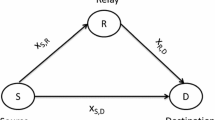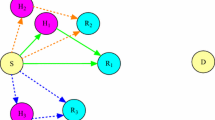Abstract
Cooperative communication (CC) allows multiple nodes to simultaneously transmit the same packet to the receiver so that the combined signal at the receiver can be correctly decoded. Since the CC can reduce the transmission power and extend the transmission coverage, it has been considered in minimum energy routing protocols to reduce the total energy consumption. However, previous research on cooperative routing only focuses on minimizing the total energy consumption from the source node to the destination node, which may lead to the unbalanced energy distribution among nodes. In this paper, we aim to study the impact of cooperative routing on balancing the energy distribution among nodes. By introducing a new routing scheme which carefully selects cooperative relay nodes and assigns their transmission power, our cooperative routing method can balance the remaining energy among neighboring nodes to maximize the lifetime of the network. Simulation results demonstrate that the proposed cooperative routing algorithm significantly balances the energy distribution and prolongs the lifetime of the network.








Similar content being viewed by others
Notes
In [11, 24], a complete communication from node v i to node v j can be achieved by CC if \((\sum_{v_k\in{v_i\cup {H(v_i)}}}\sqrt{P(v_k) \cdot(d(v_k,v_j))^{-\alpha}})^2\geq{\tau}\). This model is more realistic than the simplified model which we and [17–20] used. If we use this model in our load balancing scheme, it is difficult to get an explicit solution of the optimal remaining energy E x (we will define it in Sect. 4). Notice that the transmission power obtained under the simplified model can always guarantee that the CC transmission successes under the realistic model, since \( \sum_{v_k\in{v_i\cup {H(v_i)}}}{P(v_k) \cdot(d(v_k,v_j))^{-\alpha}} \le (\sum_{v_k\in{v_i\cup {H(v_i)}}}\sqrt{P(v_k) \cdot(d(v_k,v_j))^{-\alpha}})^2\). Therefore, we believe the results obtained by our algorithm can be directly used for the realistic model, though the perfect load balancing may not be guaranteed. Similarly, in our simplified CC model, we do not consider the fading effect since it will make the optimal remaining energy hard to solve.
References
Doshi, S., Bhandare, S., & Brown, T. X. (2002). An on-demand minimum energy routing protocol for a wireless ad hoc network. SIGMOBILE Mobile Computing and Communication Review, 6(3), 50–66.
Kar, K., Kodialam, M., Lakshman, T., & Tassiulas, L. (2003). Routing for network capacity maximization in energy-constrained ad-hoc networks. In Proceedings of IEEE conference on computer communications (INFOCOM).
Chang, J. H., & Tassiulas, L. (2000). Energy conserving routing in wireless ad-hoc networks. In Proceedings of IEEE conference on computer communications (INFOCOM).
Li, Q., Aslam, J., & Rus, D. (2001). Online power-aware routing in wireless ad-hoc networks. In Proceedings of the seventh annual international conference on mobile computing and networking. Rome, Italy: ACM Press, pp. 97–107.
Dong, Q., Banerjee, S., Adler, M. & Misra, A. (2005). Minimum energy reliable paths using unreliable wireless links. In MobiHoc ’05: proceedings of the 6th ACM international symposium on mobile ad hoc networking and computing. New York, NY, USA: ACM Press, pp. 449–459.
Stojmenovic, I., & Lin, X. (2001). Loop-free hybrid single-path/flooding routing algorithms with guaranteed delivery for wireless networks. IEEE Transactions on Parallel and Distributed Systems, 12(10).
Melodia, T., Pompili, D., & Akyildiz, I. F. (2004). Optimal local topology knowledge for energy efficient geographical routing in sensor networks. In Proceedings of IEEE conference on computer communications (INFOCOM).
Stojmenovic, I., & Datta, S. (2004). Power and cost aware localized routing with guaranteed delivery in wireless networks. Wireless Communications and Mobile Computing, 4(2), 175–188.
Seada, K., Zuniga, M., Helmy, A., & Krishnamachari, B. (2004). Energy-efficient forwarding strategies for geographic routing in lossy wireless sensor networks. In Proceedings of ACM conference on embedded networked sensor systems (Sensys).
Li, C.-P., Hsu, W.-J., Krishnamachari, B., & Helmy, A. (2005). A local metric for geographic routing with power control in wireless networks. In Proceedings of annual IEEE communications society conference on sensor, mesh, and ad hoc communications and networks (SECON).
Pandana, C., Siriwongpairat, W., Himsoon, T., & Liu, K. (2006). Distributed cooperative routing algorithms for maximizing network lifetime. In Proceedings of IEEE wireless communications and networking conference (WCNC).
Laneman, N., Tse, D., & Wornell, G. (2004). Cooperative diversity in wireless networks: Efficient protocols and outage behavior. IEEE Transactions on Information Theory, 50(12), 3062–3080.
Nosratinia, A., Hunter, T. E., & Hedayat, A. (2004). Cooperative communication in wireless networks. IEEE Communications Magazine, 42(10), 74–80.
Agarwal, M., Cho, J., Gao, L., & Wu, J. (2004). Energy efficient broadcast in wireles ad hoc networks with hitch-hiking. In Proceedings of IEEE conference on computer communications (INFOCOM).
Wu, J., Cardei, M., Dai, F., & Yang, S. (2006). Extended dominating set and its applications in ad hoc networks using cooperative communication. IEEE Transactions on Parallel and Distributed Systems, 17, 851–864.
Jakllari, G., Krishnamurthy, S., Faloutsos, M., & Krishnamurthy, P. (2007). On broadcasting with cooperative diversity in multi-hop wireless networks. IEEE Journal on Selected Area in Communications, 25, 484–496.
Cardei, M., Wu, J., & Yang, S. (2006). Topology control in ad hoc wireless networks using cooperative communication. IEEE Transactions on Mobile Computing, 5(6), 711–724.
Yu, J., Roh, H., Lee, W., Pack, S., & Du, D. -Z. (2010). Cooperative bridges: Topology control in cooperative wireless ad hoc networks. In Proceedings of the 29th IEEE conference on computer communications (IEEE INFOCOM 2010).
Zhu, Y., Huang, M., Chen, S., & Wang, Y. (2012). Energy-efficient topology control in cooperative ad hoc networks. IEEE Transactions on Parallel and Distributed Systems (TPDS), 23(8), 1480–1491.
Wang, L., Liu, B., Goeckel, D., Towsley, D. & Westphal C. (2008). Connectivity in cooperative wireless ad hoc networks. In MobiHoc ’08: Proceedings of the 9th ACM international symposium on Mobile ad hoc networking and computing, Hong Kong, China.
Shi, Y., Sharma, S., & Hou, Y. (2008) Optimal relay assignment for cooperative communications. In MobiHoc ’08: Proceedings of the 9th ACM international symposium on Mobile ad hoc networking and computing, Hong Kong, China.
Li, F., Wu, K., & Lippman, A. (2006). Energy-efficient cooperative routing in multi-hop wireless ad hoc networks. In Proceedings of IEEE international performance computing and communications conference (IPCCC 2006).
Khandani, A., Abounadi, J., Modiano, E., & Zheng, L. (2007). Cooperative routing in static wireless networks. IEEE Transaction on Communications, 55(11), 2185–2192.
Ibrahim, A., Han, Z., & Liu, K., (2008). Distributed energy-efficient cooperative routing in wireless networks. IEEE Transactions on Wireless Communications, 7(10), 3930–3941.
Zhang, J., & Zhang, Q. (2008). Cooperative routing in multi-source multi-destination multi-hop wireless networks. In Proceedings of IEEE conference on computer communications (INFOCOM).
Maham, B., Narasimhan, R., & Hjorungnes, A. (2009). Energy-efficient space-time coded cooperative routing in multihop wireless networks. In Proceedings of 28th IEEE conference on global telecommunications, (GLOBECOM 2009).
Madan, R., Mehta, N., Molisch, A., & Zhang, J. (2009). Energy-efficient decentralized cooperative routing in wireless networks. IEEE Transactions on Automatic Control, 54, 512–527.
Sharma, S., Shi, Y., Hou, Y., Sherali, H. D., & Kompella, S. (2010). Cooperative communications in multi-hop wireless networks: Joint flow routing and relay node assignment. In Proceedings of IEEE conference on computer communications (INFOCOM).
Jakllari G., Krishnamurthy, S. V., Faloutsos, M., Krishnamurthy, P. V., & Ercetin, O. (2006). A framework for distributed spatio-temporal communication in mobile ad hoc networks. In Proceedings of IEEE conference on computer communications (INFOCOM), Barcelona, Spain.
Acknowledgments
This work is supported in part by the US National Science Foundation (NSF) under Grant No. CNS-0721666, CNS-0915331, and CNS-1050398, and by Tsinghua National Laboratory for Information Science and Technology (TNList). This work was partially done when Y. Li visited the Department of Computer Science, University of North Carolina at Charlotte, with a scholarship from the China Scholarship Council. The authors also greatly appreciate the anonymous reviewers and the editor for their constructive comments for improving the paper.
Author information
Authors and Affiliations
Corresponding author
Rights and permissions
About this article
Cite this article
Chen, S., Li, Y., Huang, M. et al. Energy-balanced cooperative routing in multihop wireless networks. Wireless Netw 19, 1087–1099 (2013). https://doi.org/10.1007/s11276-012-0520-6
Published:
Issue Date:
DOI: https://doi.org/10.1007/s11276-012-0520-6




